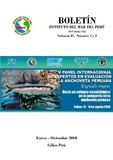Por favor, use este identificador para citar o enlazar este ítem:
https://hdl.handle.net/20.500.12958/1112Registro completo de metadatos
| Campo DC | Valor | Lengua/Idioma |
|---|---|---|
| dc.contributor.author | Díaz Acuña, Erich | |
| dc.contributor.author | García, Christian | |
| dc.contributor.author | Espinoza Morriberón, Dante | |
| dc.contributor.author | Guevara Carrasco, Renato | |
| dc.contributor.author | Csirke, Jorge | |
| dc.contributor.author | Ñiquen Carranza, Miguel | |
| dc.contributor.author | Vargas López, Nathaly | |
| dc.contributor.author | Argüelles Torres, Juan | |
| dc.date.accessioned | 2012-11-16T12:48:36Z | |
| dc.date.available | 2012-11-16T12:48:36Z | |
| dc.date.issued | 2010-12 | |
| dc.identifier.citation | Bol Inst Mar Perú. 25(1-2), 2010. p.57-61 | |
| dc.identifier.issn | 0378-7699 | |
| dc.identifier.uri | https://hdl.handle.net/20.500.12958/1112 | |
| dc.description | Boletín IMARPE vol.25, nº 1-2, 2010; p. 57-61 | es_ES |
| dc.description.abstract | Se empleó un modelo poblacional estructurado por edades para estimar la abundancia, biomasa, biomasa desovante y el reclutamiento medio del stock norte – centro de la anchoveta peruana entre los años biológicos (octubre a setiembre) 1962-63 y 2007-08. El modelo, basado en un enfoque hacia adelante, fue optimizado minimizando las diferencias de los estimados del modelo y observaciones independientes de biomasa, desembarque y estructuras por edades de los desembarques. Los resultados muestran que han existido tres regímenes de productividad de dicho stock: el primero, entre 1962-63 y 1970-71, con la abundancia, biomasa, biomasa desovante y reclutamiento medio más altos; el segundo, entre 1971- 72 y 1990-91 con los niveles poblacionales más bajos; y el tercero, entre 1991-92 y 2007-08, con niveles intermedios. Parece claro que luego del colapso de las décadas de 1970 y 1980 el stock se ha recuperado de manera significativa aunque sin alcanzar los niveles de la década de 1960. Desde el año 2001-02 la biomasa desovante se ha mantenido por encima de cinco millones de toneladas, y la mortalidad por pesca ha mostrado una tendencia decreciente. Se demostró que el presente modelo estuvo en capacidad de captar la dinámica poblacional del stock norte – centro de la anchoveta validando su utilidad en las evaluaciones y monitoreo de la población de anchoveta. | es_ES |
| dc.description.abstract | ABSTRACT: An age – structured model was carried out to estimate the mean abundance, biomass, spawning biomass and recruitment of the north – center stock of Peruvian anchoveta from 1962-63 to 2007-08, based on biological years (October to September). The model used a forward approach, and was optimized by minimizing the departures of modeled estimations from independent observations of biomass, landing and age structures of landings. Results showed the existence of three productivity regimes: the first from 1962-63 to 1970-71 with the highest mean abundance, biomass, spawning biomass and recruitment; the second, from 1971-72 to 1990-91, with the lowest population levels; and the third, from 1991-92 to 2007-08 with medium population levels. It seems clear that after the 1970 and 1980 collapse, the stock has recovered significantly but not to the 1960s levels. Since 2001-02 the spawning biomass has been maintained above five millions tones whilst fishing mortality shows a decreasing trend. It is shown that the model was able to capture the population dynamics of the north – center stock of the Peruvian anchoveta, proving its usefulness for the monitoring and assessments of the anchoveta population | |
| dc.language.iso | spa | es_ES |
| dc.publisher | Instituto del Mar del Perú | es_ES |
| dc.relation.ispartofseries | Boletín IMARPE vol.25, nº 1-2, 2010 | |
| dc.rights | info:eu-repo/semantics/openAccess | |
| dc.rights.uri | https://creativecommons.org/licenses/by/4.0/ | |
| dc.source | Instituto del Mar del Perú - IMARPE | |
| dc.source.uri | Repositorio Digital IMARPE | |
| dc.subject | Modelo Poblacional | es_ES |
| dc.subject | Anchoveta | es_ES |
| dc.title | Evaluación del stock norte – centro de la anchoveta peruana (Engraulis ringens Jenyns) por un modelo estadístico estructurado por edades | es_ES |
| dc.title.alternative | Assessment of the north – center stock of Peruvian anchoveta (Engraulis ringens Jenyns) using an age structured model | |
| dc.type | info:eu-repo/semantics/article | es_ES |
| Aparece en las colecciones: | Boletín 25(1-2), 2010 | |
Ficheros en este ítem:
| Fichero | Descripción | Tamaño | Formato | |
|---|---|---|---|---|
| BOL 25(1-2)-8.pdf | 2 MB | Adobe PDF |  Visualizar/Abrir |
Este ítem está sujeto a una licencia Creative Commons Licencia Creative Commons

